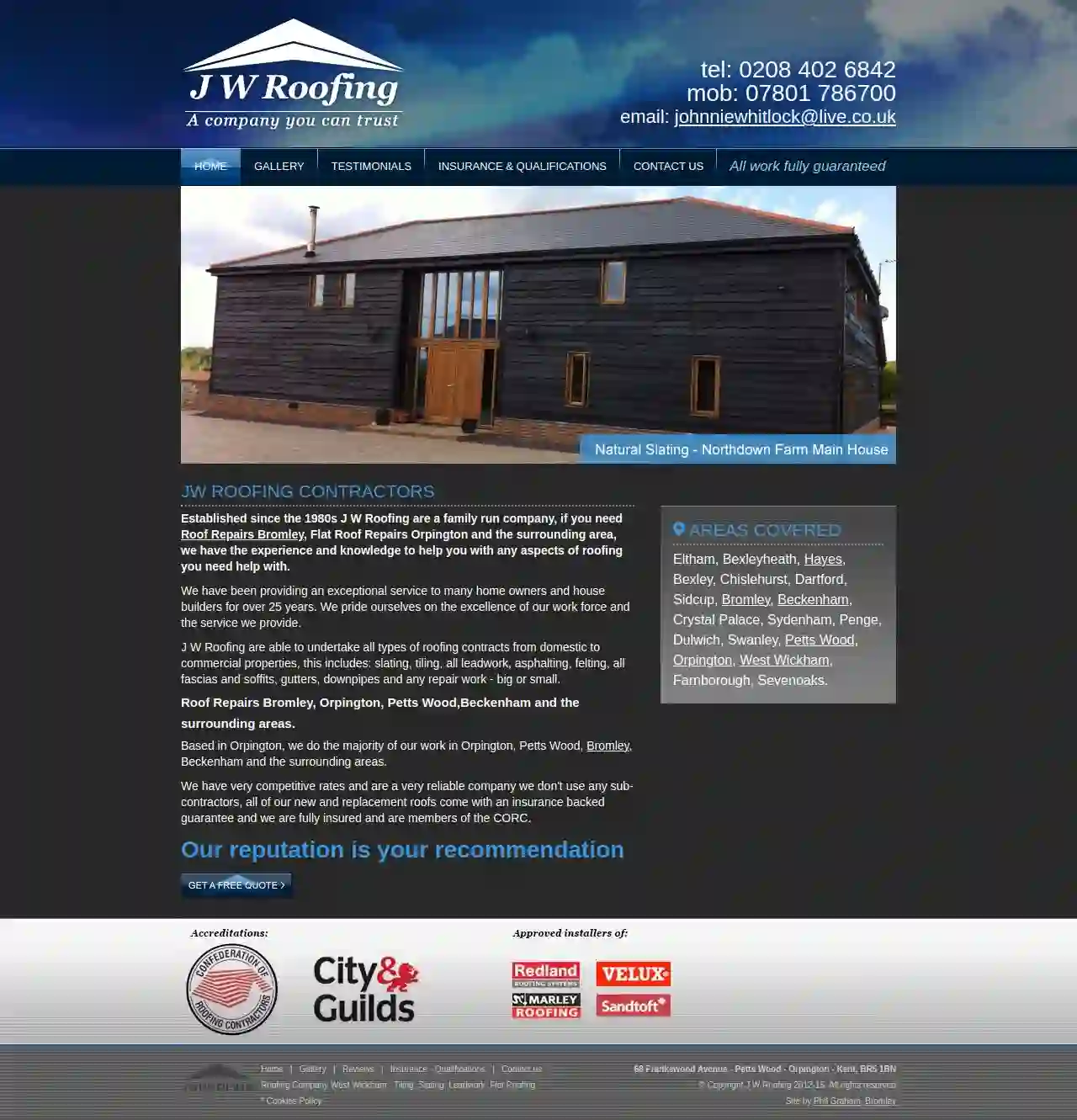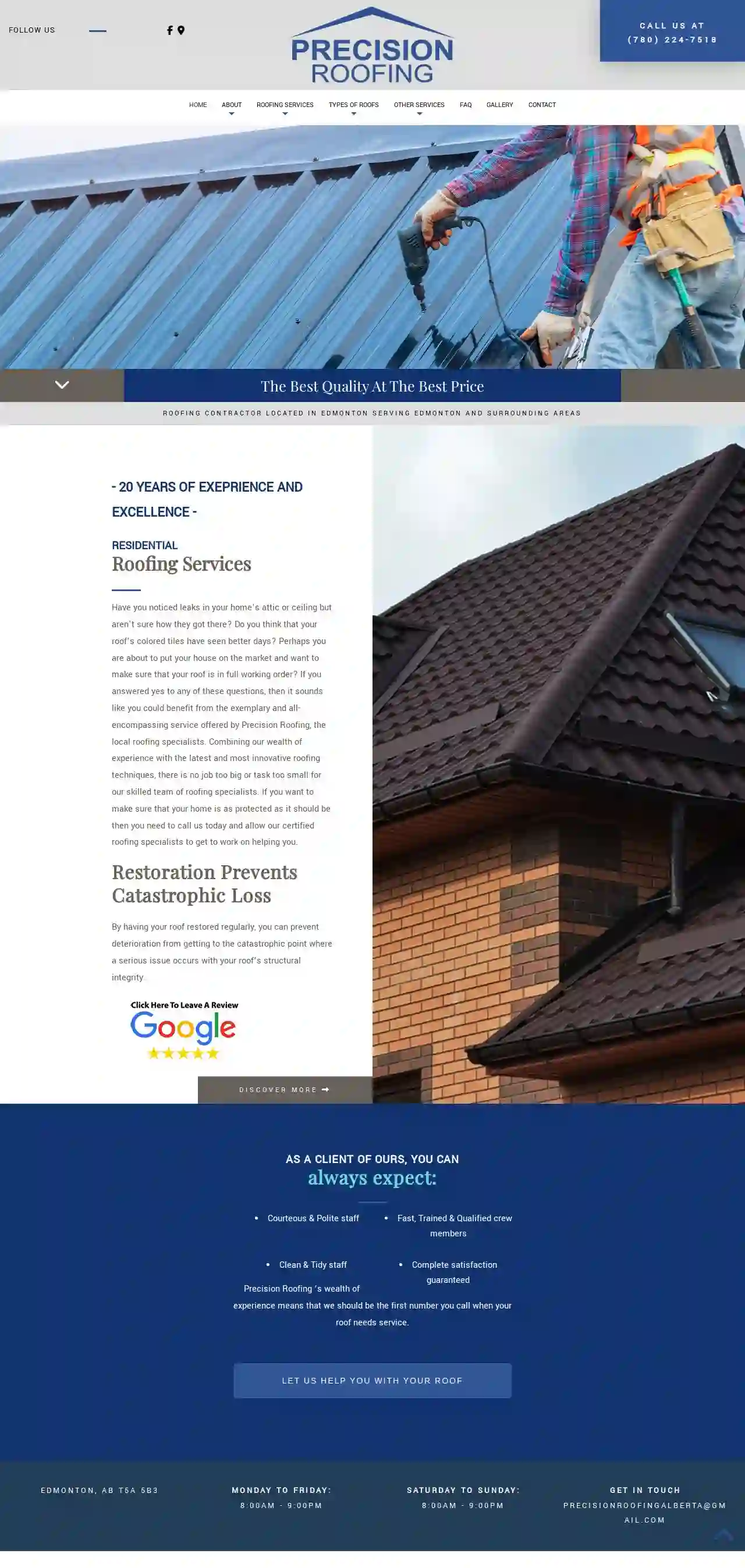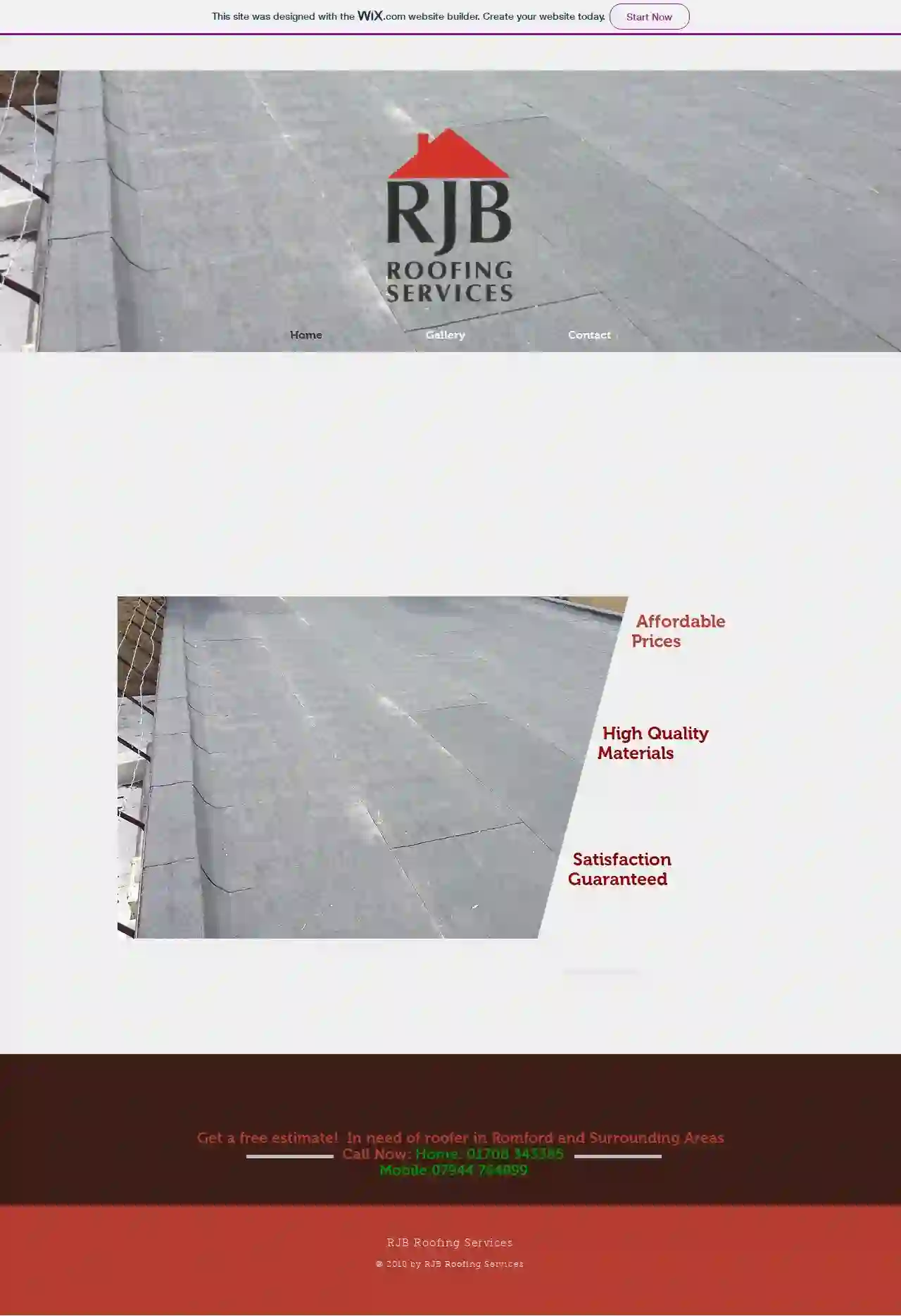Rubber Roof Installers Dagenham
Best EPDM Roof Installers in Dagenham
Receive 3 FREE Rubber Roof Installation quotes for your project today! Compare profiles, reviews, accreditations, portfolio, etc... and choose the best offer.

Specialised Roofline Supplies (Hampshire) Ltd
52 reviews3 Stanhope Gate, Yorktown Business Park, Yorktown, GBSRS UPVC is your one-stop shop for all your building, roofing, window and door products. We pride ourselves on offering a wide range of high-quality products at trade prices, all under one roof. Whether you're looking for fascia and soffit, guttering, windows, doors, or roofing materials, we have everything you need to complete your project. Our team of experts is always on hand to offer advice and guidance, ensuring you choose the right products for your needs. We also offer a bespoke service for windows and doors, so you can be sure to get the perfect fit for your home. At SRS UPVC, we're committed to providing our customers with the best possible service and products. We're proud to be a trusted supplier to both trade professionals and DIY enthusiasts alike. Visit our showroom in Folkestone or Farnborough today to see our full range of products.
- Services
- Why Us?
- Gallery
Get Quote
A1 Roofing Romford
53 reviews14 Main Road, Romford, RM1 3DA, GBA1 Roofing Romford is a roofing services company based in Romford, Greater London, UK. We offer a range of services including roof insulation, guttering, soffits repair & replacement, fascia repair & replacement, roof waterproof membrane, and chimney repair. Our team is dedicated to providing 24-hour, seven-day-a-week roofing services to our clients in Romford and surrounding areas. We serve a diverse clientele, including residential and commercial customers, and are committed to delivering high-quality workmanship and excellent customer service.
- Services
- Why Us?
- Accreditations
- Our Team
- Testimonials
- Gallery
Get Quote
R J Evans Flat Roofing Limited
4.715 reviews1 Palmers, 101 Crow Green Road, Brentwood, Essex, CM15 9RP, GBRJ Evans Flat Roofing Ltd are a roofing contractor based in Brentwood, Essex. We have developed a reputation as one of London's leading flat roofing companies and aspire to be one of the leading roofers in the UK. Our specialist roofers provide flat roofing services for residential and commercial clients across London, Essex and the whole of the UK. In addition to our roofing services we also provide specialist waterproofing services including the installation and repair of asphalt steps, balconies. As well as basement tanking. Whatever your roofing or waterproofing needs we will provide you with the highest levels of customer service. All our work comes with full guarantees of up to 40 years. And our roofers will make sure your work is finished on time and within budget. Throughout any project you undertake with us you will benefit from our dedicated support team before, during and after your project is complete. From roof repairs and flat roof replacements to asphalt steps we will give you the highest quality service. If you would like to contact us about anything about roofs or waterproofing just pick up the phone today and call 01277 260 204, one of our friendly team will be delighted to help.
- Services
- Why Us?
- Accreditations
- Our Team
- Testimonials
- Gallery
Get Quote
J W Roofing
3.912 reviews68 Frankswood Avenue, Petts Wood, BR5 1BN, GBEstablished since the 1980s J W Roofing are a family run company, if you need Roof Repairs Bromley, Flat Roof Repairs Orpington and the surrounding area, we have the experience and knowledge to help you with any aspects of roofing you need help with. We have been providing an exceptional service to many home owners and house builders for over 25 years. We pride ourselves on the excellence of our work force and the service we provide. J W Roofing are able to undertake all types of roofing contracts from domestic to commercial properties, this includes: slating, tiling, all leadwork, asphalting, felting, all fascias and soffits, gutters, downpipes and any repair work - big or small. Roof Repairs Bromley, Orpington, Petts Wood,Beckenham and the surrounding areas. Based in Orpington, we do the majority of our work in Orpington, Petts Wood, Bromley, Beckenham and the surrounding areas. We have very competitive rates and are a very reliable company we don't use any sub-contractors, all of our new and replacement roofs come with an insurance backed guarantee and we are fully insured and are members of the CORC. Our reputation is your recommendation
- Services
- Why Us?
- Accreditations
- Gallery
Get Quote
Alltype Roofing Orpington
4.615 reviewsUnknown, GBAllType Roofing is a leading supplier of roofing materials and solutions. With a wide range of products and services, we cater to the needs of both trade and DIY customers. Our extensive product portfolio includes roof tiles, slate, concrete roof tiles, clay roof tiles, pitched roofing, flat roofing, and more. We also offer a variety of accessories and fixings to ensure a seamless installation process. At AllType Roofing, we pride ourselves on providing excellent customer service, competitive pricing, and a commitment to quality. Whether you're a professional roofer or a DIY enthusiast, we have everything you need to complete your roofing project.
- Services
- Why Us?
- Accreditations
- Gallery
Get Quote
BulletProof Roofing
4.522 reviews2-2207 90B St SW, Edmonton, T6E 4M9, GBBulletProof Roofing is a trusted Edmonton roofing company dedicated to providing exceptional service and delivering honest work within your budget. We pride ourselves on the quality of every roof we install, ensuring your home is in safe hands with our trained professionals. From simple repairs to full roof installations, we've got you covered. We offer a wide range of shingle options in various colors and styles to complement your project. Our work is weatherproof and backed by 20+ years of hands-on experience. Contact us today for a professional estimate and experience the BulletProof difference!
- Services
- Why Us?
- Our Team
- Testimonials
- Gallery
Get Quote
Weatherproof Roofing Inc.
4.9148 reviews15391 117 Avenue NW, Edmonton, T5M 3X4, GBWe’re on top of it. Specializing in roof replacement, emergency roof repair, and new roof installation. Your home’s best defence against moisture, the elements, and pests is its roofing. Edmonton homeowners want an affordable roofing contractor who has the experience and knowledge to fix or replace their roof. The skilled, professional roofers at Weatherproof Roofing will ensure any roof replacement or roof repair is done right the first time, every time. For metal roofing, tiles, shingles, or eavestrough, Edmonton residents trust Weatherproof Roofing to get the job done. When you choose us, you’ll enjoy a roof with superior aesthetic quality and the best level of protection for your greatest asset: your home.
- Services
- Why Us?
- Accreditations
- Our Team
- Testimonials
- Gallery
Get Quote
CJ Roofing and Property Maintenance Ltd
4.825 reviews22 Stalisfield Place, Orpington, BR6 7HN, GBC J Roofing & Property Maintenance Ltd is a family-run roofing company with a great reputation across Kent. We work as flexibly as possible for you, the client, and can outline the materials and processes we use, work weekends if needed or even extend our hours into the evening. We pride ourselves on resolving leaks, broken gutters, damaged tiles, and all other pitched and flat roofing issues in record time. Our team also fits the latest re-roofing products for long-term coverage that continues to look great in all seasons. We lend these skills to domestic and commercial properties across Kent, defending interiors from the rain often seen in Orpington, Bromley and the surrounding areas. When it comes to roofing and property maintenance, you needn't just take our word for it. Instead, you can find us on Rated People, Trustatrader and Checkatrade, where our reviews speak for themselves. For the ultimate peace of mind, we supply 10-year guarantees for all new roofs and five-year coverage for flat roofing systems.
- Services
- Why Us?
- Accreditations
- Our Team
- Testimonials
- Gallery
Get Quote
Precision Roofing
55 reviewsEdmonton, T5A 5B3, GBPrecision Roofing is a family-owned and operated roofing contractor serving Edmonton and surrounding areas. With over 20 years of experience, we pride ourselves on providing high-quality workmanship and exceptional customer service. Our team of fully licensed, insured, and bonded professionals is dedicated to delivering affordable and reliable roofing solutions for all your needs. Whether you require new roof installation, shingle or metal roofing, or expert roof repair, Precision Roofing is your trusted partner. We offer a full range of services, ensuring your roof is protected and in top condition. From initial consultation to project completion, we strive to exceed your expectations. Contact us today for a free estimate and experience the Precision Roofing difference.
- Services
- Why Us?
- Gallery
Get Quote
RJB Roofing Services
551 reviewsRomford, GBWith over 20 years of experience in the Roofing trade, we provide roofing services for the domestic and commercial markets. Our Services Include: Flat Roofs (Repair or Removal) Roof Repairs Roof Replacement Tiling and slating Guttering and Downpipes uPVC Soffits and Facias Velux Installation Lead Work Repairs and Replacement Chimney Re-Pointing and Rendering Interior and Exterior Painting Garden Fencing Gutter Cleaning Driveway Cleaning Bricklaying And Much More Satisfaction Guaranteed Affordable Prices High Quality Materials Get a free estimate! In need of a roofer in Romford and Surrounding Areas Call Now: Home: 01708 343385 Mobile:07944 764899
- Services
- Why Us?
- Gallery
Get Quote
Over 12,314+ Roofers registered
Our roofing experts operate in Dagenham and beyond!
Roofyng.co.uk has curated and vetted Top Roofing Companies in and around Dagenham. Find a trustworthy contractor today.
Rubber Roof Installation FAQs
- Clean the Area: Clean the area around the tear with a mild detergent and water, ensuring it's completely dry before proceeding.
- Cut a Patch: Cut a patch of EPDM membrane material that is slightly larger than the tear, ensuring it overlaps the damaged area by at least 2 inches on all sides.
- Apply Adhesive: Apply a specialized EPDM adhesive to the underside of the patch and the roof surface around the tear, following the manufacturer's instructions.
- Position the Patch: Carefully position the patch over the tear, pressing it firmly into place to ensure good adhesion.
- Roll the Patch: Use a roller to press out any air bubbles and ensure a smooth, even bond between the patch and the roof surface.
- Apply Sealant: Apply a bead of sealant around the patch's edges to provide additional protection against leaks.
- Inspect and Test: Once the adhesive and sealant have cured, inspect the repaired area and perform a water test to ensure it's watertight.
- Visual Inspections: Inspect the roof at least twice a year (spring and fall) for any signs of damage, such as cracks, punctures, or seam separation.
- Debris Removal: Keep the roof surface clear of leaves, branches, and other debris that can trap moisture and cause deterioration.
- Seam Inspection: Periodically inspect the seams of the EPDM membrane to ensure they are properly sealed and not showing signs of deterioration or separation.
- Flashing Inspection: Check the flashing around vents, pipes, and other penetrations to ensure it's in good condition and securely attached.
- Ponding Water: If you notice ponding water on your flat roof, address the drainage issue promptly to prevent damage to the roofing membrane.
- Professional Inspections: Consider having a professional roofing contractor inspect your rubber roof every few years for a more thorough assessment.
How do I repair a tear in my rubber roof?
Here's a general overview of the process:
Do rubber roofs require a lot of maintenance?
How do I find rubber roof installers in my area?
What is a rubber roof?
How do I repair a tear in my rubber roof?
Here's a general overview of the process:
- Clean the Area: Clean the area around the tear with a mild detergent and water, ensuring it's completely dry before proceeding.
- Cut a Patch: Cut a patch of EPDM membrane material that is slightly larger than the tear, ensuring it overlaps the damaged area by at least 2 inches on all sides.
- Apply Adhesive: Apply a specialized EPDM adhesive to the underside of the patch and the roof surface around the tear, following the manufacturer's instructions.
- Position the Patch: Carefully position the patch over the tear, pressing it firmly into place to ensure good adhesion.
- Roll the Patch: Use a roller to press out any air bubbles and ensure a smooth, even bond between the patch and the roof surface.
- Apply Sealant: Apply a bead of sealant around the patch's edges to provide additional protection against leaks.
- Inspect and Test: Once the adhesive and sealant have cured, inspect the repaired area and perform a water test to ensure it's watertight.
Do rubber roofs require a lot of maintenance?
- Visual Inspections: Inspect the roof at least twice a year (spring and fall) for any signs of damage, such as cracks, punctures, or seam separation.
- Debris Removal: Keep the roof surface clear of leaves, branches, and other debris that can trap moisture and cause deterioration.
- Seam Inspection: Periodically inspect the seams of the EPDM membrane to ensure they are properly sealed and not showing signs of deterioration or separation.
- Flashing Inspection: Check the flashing around vents, pipes, and other penetrations to ensure it's in good condition and securely attached.
- Ponding Water: If you notice ponding water on your flat roof, address the drainage issue promptly to prevent damage to the roofing membrane.
- Professional Inspections: Consider having a professional roofing contractor inspect your rubber roof every few years for a more thorough assessment.